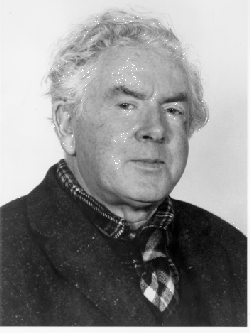- Home Page
- General Overview
- Group Members
- Current Members
Recent Members - Publications
- Recent Papers
Complete List
Nucleotide Sequences - Links Pool
- Biodegradation Related
Sequence Retrieval
Biological Science Journals
Freeware & Shareware
Useful Molecular Biology Homepages
Molecular Biological Companies - Contact Details
- School of Biological Sciences

Bangor Biodegradation Group
The W. Charles Evans Memorial Page
Professor William Charles Evans F.R.S.

The career of W. Charles Evans spanned and reflected
the period during which biochemistry grew from small origins in other disciplines
such as agriculture and medicine into an important academic subject in
its own right.
He was a dedicated and gifted experimental biochemist
and organic chemist who knew how to transmit his dedication to scientific
research and love of his subject to his colleagues and students. Born within
a few miles of Bangor, he obtained a scholarship to the University College
of North Wales at Bangor where he obtained a 1st class degree in Chemistry.
He subsequently moved to Manchester University for postgraduate studies
and was awarded his PhD in 1937 for work on tyrosinases in plant and animal
tissues. In 1937, he was appointed to a lectureship at Leeds University
where his head of department, Dr. Frank Happold, introduced him to bacteria
and to their ability to metabolise aromatic compounds: this was to form
the basis of his most important later work. In 1951 he returned to Bangor
as Professor of Agricultural Chemistry (later changed to Biochemistry &
Soil Science). Here he anticipated many ecological concerns about pollution
caused by the release of man-made compounds into the environment 20 years
before the rest of society.
Although he also worked on animal toxicology, in particular the effect of bracken (Pteridium aquilinum) on cattle, he will be remembered chiefly for his major contributions to the field of microbial degradation. From 1950-79 Evans and his students were instrumental in delineating the major biochemical pathways by which bacteria degrade aromatic compounds under both aerobic and anaerobic conditions. He played a part in the elucidation of both the ortho and meta cleavage pathways for aerobic degradation and produced the main outlines of the anaerobic photosynthetic pathway in Rhodopseudomonas palustris. He also defined the catabolic routes by which a number of important compounds proceeded including naphthalene and the chlorophenoxyacetate herbicides. Our present knowledge of the biodegradability of these substances, present in the environment as industrial wastes, agrochemicals and natural products, is based on the foundations laid down by Evans and his students and also by his contemporaries, Stanley Dagley (in UK and later the USA), Roger Stanier (in USA) and Osamu Hayaishi (in Japan).
For a full biography and bibliography see J.R.Quayle, Biographical Memoirs (1994), pp.87-103, The Royal Society, London.

